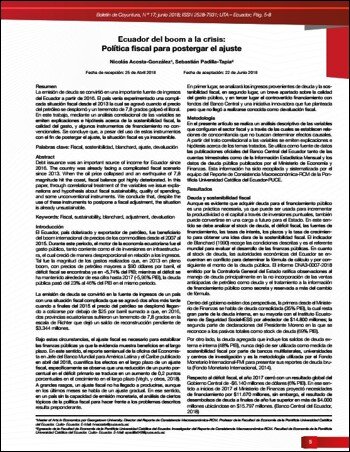Ecuador del boom a la crisis: política fiscal para postergar el ajuste
Contenido principal del artículo
Resumen
La emisión de deuda se convirtió en una importante fuente de ingresos del Ecuador a partir de 2016. El país venía experimentado una complicada situación fiscal desde el 2013 la cual se agravó cuando el precio del petróleo se desplomó y un terremoto de 7,8 grados golpeó el litoral. En este trabajo, mediante un análisis correlacional de las variables se emiten explicaciones e hipótesis acerca de la sostenibilidad fiscal, la calidad del gasto, y algunos instrumentos de financiamiento no convencionales. Se concluye que, a pesar del uso de estos instrumentos con el fin de postergar el ajuste, la situación fiscal es ya insostenible.
DOI: https://doi.org/10.31164/bcoyu.17.2018.665
URL: http://revistas.uta.edu.ec/erevista/index.php/bcoyu/article/view/665
Descargas
Detalles del artículo

Esta obra está bajo una licencia internacional Creative Commons Atribución-NoComercial 4.0.
![]()
Las publicaciones del Boletín de Coyuntura están bajo una licencia de Creative Commons Reconocimiento-NoComercial 4.0 Internacional (CC BY-NC 4.0). La Universidad Técnica de Ambato conserva los derechos patrimoniales (copyright) de las obras publicadas, y favorece y permite la reutilización de estas, siempre que: se cite la autoría y fuente original de su publicación, no se usen para fines comerciales u onerosos. La propiedad intelectual de los artículos publicados pertenece a los autores de los mismos.
Citas
Afonso, A., Schuknetch, L., & Tanzi, V. (2005). Public Sector Efficiency: Evidence for new EU Members States and Emerging Markets. European Central Bank Working Paper Series, 581. Recuperado de: https://www.ecb.europa.eu/pub/pdf/scpwps/ecbwp581.pdf?2c269a35246a4084e4df9e077ede9bc1
Armendáriz, E., & Eduardo, C. (2016). La eficiencia del gasto de inversión pública en América Latina. XXI Congreso Internacional del CLAD sobre la Reforma del Estado y de la Administración Pública, Santiago, Chile, 8-11 noviembre de 2016. Recuperado de: http://www2.congreso.gob.pe/sicr/cendocbib/con4_uibd.nsf/3B0BFEE130669F58052580B200813641/$FILE/armendar.pdf
Banco Central del Ecuador. (2018). Información Estadística Mensual, Boletín 1993, marzo 2018. Recuperado de: https://contenido.bce.fin.ec/home1/estadisticas/bolmensual/IEMensual.jsp
Barrios, S., & Schaechter, A. (2009). Gauging by numbers: A first at-tempt to measure the quality of public finances in the EU. European Commission, Economic Papers, 382. Recuperado de: http://ec.europa.eu/economy_finance/publications/pages/publication15781_en.pdf
Blanchard, O. (1990). Suggestions for a New Set of Fiscal Indicators. OECD Economics Department Working Papers, 79, OECD Publishing, Paris. DOI: http://dx.doi.org/10.1787/435618162862.
Boscá, J., Doménech, R., & Ferri, J. (2013). Fiscal Devaluations in EMU. BBVA Research Working Papers, 12 (11). Recuperado de: https://www.bbvare-search.com/KETD/fbin/mult/WP_1211_tcm348-338126.pdf
Contraloría General del Estado. (2018). Informe DNA3-0007-2018. Recuperado de: http://www.contraloria.gob.ec/WFDescarga.aspx?id=52076&tipo=inf
Fondo Monetario Internacional. (2014). Manual de Estadísticas de Finanzas Públicas. Recuperado de: https://www.imf.org/external/Pubs/FT/GFS/Manual/2014/GFSM_2014_SPA.pdf
Minsterio de Economía y Finanzas (2018). Boletín Deuda Externa Nro. 253, enero 2018. Recuperado de: http://www.finanzas.gob.ec/wp-content/up-loads/downloads/2018/02/DE_ENERO-2018.pdf
Ribeiro, M. (2008). Eficiencia do gasto publico na America Latina: uma analise comparativa a partir do modelo semi-paramétrico com estimativa em dois estágios. Gestión Pública, 67. Recuperado de: https://repositorio.cepal.org/bit-stream/handle/11362/7329/1/S0800275_pt.pdf
Standard & Poor’s Financial Services. (2018). Listado de Calificaciones por Emisor América Latina de SP Global Ratings. Recuperado de: https://www.standardandpoors.com/es_LA/delegate/getPDF?articleId=2032759&-type=COMMENTS&subType=REGULATORY
Végh, C., Vuletin, G., Riera-Crichton, D., Friedheim, D., Morano, L., & Camarena, J. A. (2018). “Fiscal Adjustment in Latin America and the Caribbean: ¿Short-Run Pain, Long-Run Gain? LAC Semiannual Report (abril), World Bank Publications, The World Bank Group. Recuperado de: https://openknowledge.worldbank.org/bitstream/handle/10986/29666/211290SP.pdf?sequence=6&is-Allowed=y


